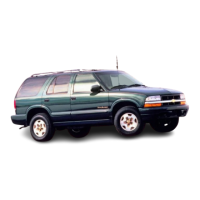Do you have a question about the Chevrolet 1999 Astro and is the answer not in the manual?
Describes how to adjust, remove, and install seats, including bucket and bench types, power seats, and head restraints.
Explains the proper use of safety belts and what not to do with them, plus information on the air bag system.
Provides instructions for adults on wearing safety belts, focusing on driver position and lap-shoulder belt usage.
Details the vehicle's 'Next Generation' frontal air bags, their function, and safety precautions related to inflation.
Information on the vehicle's double-sided key for ignition and door locks, and the importance of having extra keys.
Explains how to lock and unlock doors, including manual and power door lock systems for safety.
Describes the five different ignition key positions (Accessory, Lock, Off, Run, Start) and their functions.
Details the different positions of the shift lever (P, R, N, D, 3, 2, 1) and their operational functions.
Guides operation of the air system, including fan, temperature, and function knobs for heating, cooling, and ventilation.
Details the controls for the vehicle's heating and air conditioning system, including specific knob functions.
Covers operation of the Delco Electronics audio system, including clock setting and radio functions.
Instructions for loading, playing, and controlling cassette tapes, including REV, FWD, RECALL, and EJECT functions.
Provides fundamental advice on driving defensively, emphasizing anticipation and maintaining safe following distances.
Highlights the dangers of alcohol-impaired driving and its effects on judgment, coordination, vision, and attentiveness.
Explains braking action, perception time, reaction time, and factors affecting stopping distances.
Offers tips on steering, particularly driving on curves and handling emergencies.
Details the function and operation of hazard warning flashers to alert others and indicate a vehicle problem.
Provides safety steps for jump starting a vehicle with jumper cables, including battery cautions.
Offers guidance and cautions on proper towing procedures to avoid vehicle damage and ensure safety.
Addresses issues of engine overheating, steam from the engine, and steps to take to prevent further damage.
Recommends dealer service for vehicle maintenance and highlights the benefits of genuine GM parts.
Provides guidance on selecting the correct unleaded gasoline (87 octane or higher) for optimal vehicle performance.
Explains how to check engine oil level, what kind of oil to use, and when to change it.
Covers tire maintenance, including inflation pressure, treadwear, traction, temperature grades, and rotation.
Details maintenance services required for the vehicle, divided into Short Trip/City and Long Trip/Highway schedules.
Provides specific maintenance intervals and services for vehicles used in city driving or for short trips.
Outlines maintenance intervals and services for vehicles primarily used for long-distance highway driving.
Lists owner-performed checks and services for vehicle safety, dependability, and emission control performance.
Outlines a step-by-step process for resolving customer concerns with the dealership and Chevrolet.
Details the free roadside assistance program, including services like towing, jump starts, and fuel delivery.
Explains the courtesy transportation options available for customers during warranty repairs.
Instructs owners on how to report safety defects directly to General Motors for investigation and action.
References pages related to the vehicle's air bag system, including its operation and safety.
Index entries covering brake system components, operation, and maintenance.
Information pertaining to the proper use and selection of child restraint systems for vehicle safety.
Index entries related to engine oil, including checking levels, adding oil, and oil specifications.
Describes how to adjust, remove, and install seats, including bucket and bench types, power seats, and head restraints.
Explains the proper use of safety belts and what not to do with them, plus information on the air bag system.
Provides instructions for adults on wearing safety belts, focusing on driver position and lap-shoulder belt usage.
Details the vehicle's 'Next Generation' frontal air bags, their function, and safety precautions related to inflation.
Information on the vehicle's double-sided key for ignition and door locks, and the importance of having extra keys.
Explains how to lock and unlock doors, including manual and power door lock systems for safety.
Describes the five different ignition key positions (Accessory, Lock, Off, Run, Start) and their functions.
Details the different positions of the shift lever (P, R, N, D, 3, 2, 1) and their operational functions.
Guides operation of the air system, including fan, temperature, and function knobs for heating, cooling, and ventilation.
Details the controls for the vehicle's heating and air conditioning system, including specific knob functions.
Covers operation of the Delco Electronics audio system, including clock setting and radio functions.
Instructions for loading, playing, and controlling cassette tapes, including REV, FWD, RECALL, and EJECT functions.
Provides fundamental advice on driving defensively, emphasizing anticipation and maintaining safe following distances.
Highlights the dangers of alcohol-impaired driving and its effects on judgment, coordination, vision, and attentiveness.
Explains braking action, perception time, reaction time, and factors affecting stopping distances.
Offers tips on steering, particularly driving on curves and handling emergencies.
Details the function and operation of hazard warning flashers to alert others and indicate a vehicle problem.
Provides safety steps for jump starting a vehicle with jumper cables, including battery cautions.
Offers guidance and cautions on proper towing procedures to avoid vehicle damage and ensure safety.
Addresses issues of engine overheating, steam from the engine, and steps to take to prevent further damage.
Recommends dealer service for vehicle maintenance and highlights the benefits of genuine GM parts.
Provides guidance on selecting the correct unleaded gasoline (87 octane or higher) for optimal vehicle performance.
Explains how to check engine oil level, what kind of oil to use, and when to change it.
Covers tire maintenance, including inflation pressure, treadwear, traction, temperature grades, and rotation.
Details maintenance services required for the vehicle, divided into Short Trip/City and Long Trip/Highway schedules.
Provides specific maintenance intervals and services for vehicles used in city driving or for short trips.
Outlines maintenance intervals and services for vehicles primarily used for long-distance highway driving.
Lists owner-performed checks and services for vehicle safety, dependability, and emission control performance.
Outlines a step-by-step process for resolving customer concerns with the dealership and Chevrolet.
Details the free roadside assistance program, including services like towing, jump starts, and fuel delivery.
Explains the courtesy transportation options available for customers during warranty repairs.
Instructs owners on how to report safety defects directly to General Motors for investigation and action.
References pages related to the vehicle's air bag system, including its operation and safety.
Index entries covering brake system components, operation, and maintenance.
Information pertaining to the proper use and selection of child restraint systems for vehicle safety.
Index entries related to engine oil, including checking levels, adding oil, and oil specifications.
| Brand | Chevrolet |
|---|---|
| Model | 1999 Astro |
| Category | Automobile |
| Language | English |











